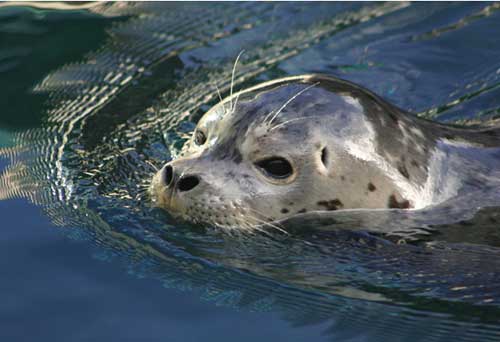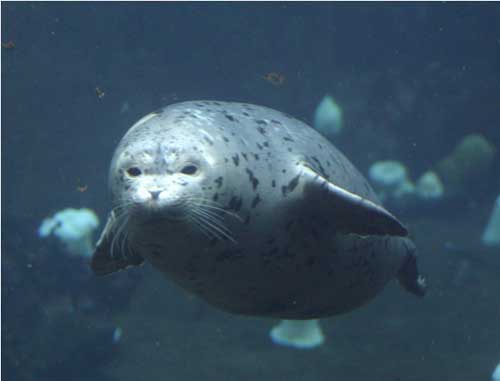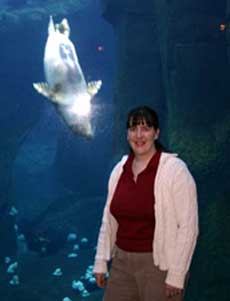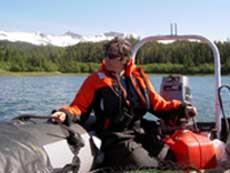 February 16, 2005
Harbor seals Atuun, Qilak, Susitna, and Miki were barely two months old when they were brought to the Alaska SeaLife Center in Seward last summer. Now more than six months old, they still turn up their noses when offered a meal of squid. Lori Polasek is a marine mammal biologist at the center. 
These seals don't know it, but they may hold the key to helping their species recover.
Harbor seals were once as common as the rain that falls steadily much of the year along coastal Alaska. Anne Hoover-Miller is a marine mammal biologist with the Alaska SeaLife Center. Hoover-Miller said, "They were probably the most commonly seen marine mammal along the coast. They were hauled out along the shoreline everywhere. People pretty much assumed there were lots of seals and that there always would be lots of seals." So numerous, that for a time in the 1950s a bounty was paid on seals to lessen their impact on commercial salmon stocks. In 1972 the federal Marine Mammal Protection Act prohibited all except Alaska Natives from harvesting seals. Theoretically at least, seal numbers should have begun to climb. But instead, Hoover-Miller says seal numbers plummeted. The first sign of trouble was seen around Kodiak Island. Hoover-Miller said, "What actually happened was the seal populations in the Kodiak Island area began declining quite rapidly through the mid to late 1970s, and the number through 1994 declined about 90 percent." From there, the decline quickly spread eastward to Cook Inlet and Prince William Sound, and west through the Aleutian Islands. Only seal populations in Southeast Alaska remained stable. Scientists say the decline
followed a dramatic shift in the kinds of fish available for
seals to eat. Fat, energy-giving fish like herring, capelin,
and sand lance, were replaced by low-fat, nutritionally questionable
fish like pollock. If you're a marine mammal, high-fat prey is
important to everything from warding off the bitter cold water
to producing healthy milk for newborn pups. The shift in food
didn't hurt just seals. Most scientists believe it triggered
dramatic declines in Steller sea lions, fur seals, and seabirds. Back at the SeaLife Center, researchers are trying to understand just how a diet of low-fat fish might affect harbor seals' ability to grow and reproduce. That's where Atuun, Qilak, Susitna, and Miki come in. Lori Polasek says Susitna and Miki are fed a steady diet of herring that are about 20 percent lower in fat than herring fed to Atuun and Qilak. Polasek said, "This is the first time that the SeaLife Center has done a diet study in which everything remains the same in the diet except seals are getting a low fat herring or a high fat herring. There's still capelin, there's still pollock in the diet. There will eventually be squid in the diet. So it's still a mixed diet. The only factor that will change is the fat." Over time, Polasek says a low-fat diet may affect harbor seals in subtle, but important ways. Researchers will conduct a host of tests aimed at gauging the health of the seals. They'll take regular blood samples to look for the presence of stress hormones. And they'll monitor the seal's growth to see if it's slower or stunted in the seals that don't get enough fat in their diet. Polasek said, "And so there are several things we're looking for. Will there be changes in the effects of hormones over the season? Will there be delayed maturation in seals on the low-fat diet? Will they have a lower capability of onlaying fat in the winter? And what affect will that have on different health parameters in the seals? Of course, we don't want to drive these low fat seals into something where they would become unhealthy. We are definitely monitoring them very closely to make sure they remain healthy. But at what point are these seals stressed under conditions of low fat?" What Polasek sees with her captive seals will be compared to what Hoover-Miller sees in the wild. 
Hoover-Miller says that whatever triggered the decline of harbor seals in the 1970s probably isn't what's keeping seal numbers low today. Hoover-Miller said, "We may be looking at different impacts precipitated by the decline. Availability of food may have precipitated the decline. The animals may have stabilized at a low number where the food is not impacting them quite so hard. But then the predator effect may be interfering with their ability to recover as quickly. So there are a lot of components that we need to put in." For the moment, researchers will focus on the effects of diet on the health of harbor seals. From the study, Polasek and Hoover-Miller hope to develop a profile of what constitutes a healthy and unhealthy harbor seal. Knowing more about what it means to be a healthy seal will help scientists monitor the recovery of harbor seals across the state.
This story is courtesy of Arctic Science Journeys. ASJ is a radio service highlighting science, culture, and the environment of the circumpolar north. Produced by the Alaska Sea Grant College Program and the University of Alaska Fairbanks.
|
||||

